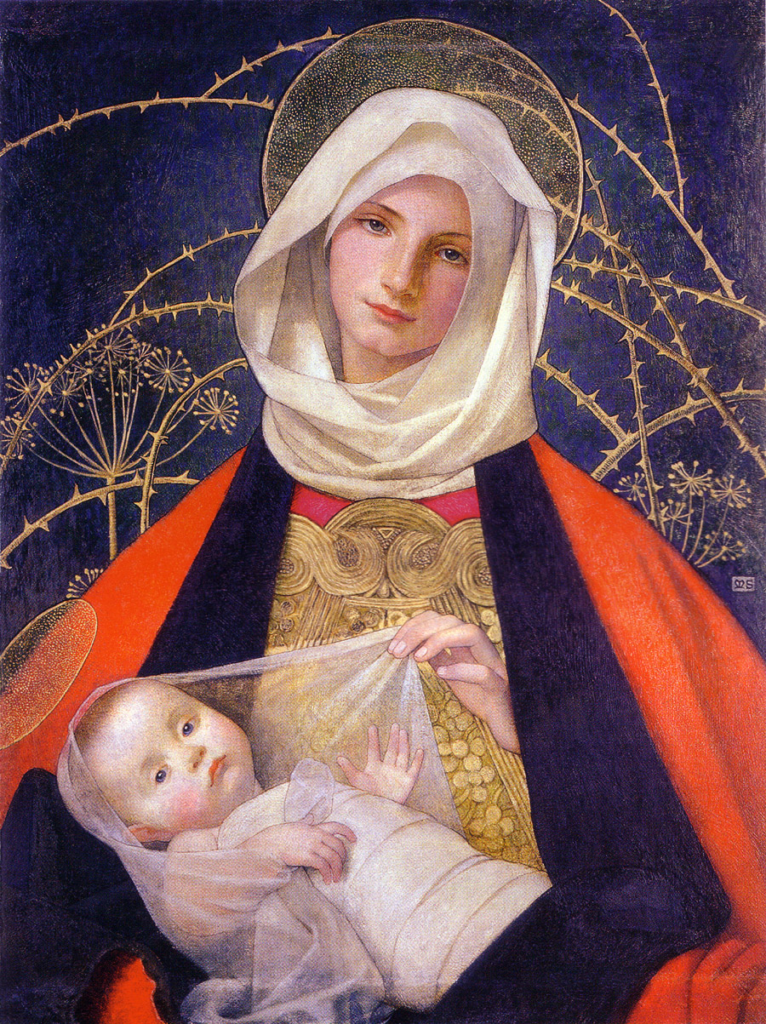The angel said to her, “Don’t be afraid, Mary, for you have found favor with God. Behold, you will conceive in your womb, and bring forth a son, and will call his name ‘Jesus.’ He will be great, and will be called the Son of the Most High. The Lord God will give to him the throne of his father, David, and he will reign over the house of Jacob forever. There will be no end of his kingdom.” Luke 1:30-33
So much attention has been given to Mary in art history. From the Middle Ages through the Renaissance, and beyond, countless paintings of “The Madonna and Child” have been created. Many of them have a similar composition to this painting and similar decorative quality. And many are near-idolatrous, putting Mary in a queenly position with even more honor than the infant Christ. This painting, while celebrating Mary and her unique role in God’s redemption plan, does not elevate her to an idolatrous status. Instead, it helps us to encounter her as a vessel God used to bring his Son to us. It strikes an interesting balance between old iconography and the contemporary sentimental and realistic depictions of Mary.
Marianne Stokes was considered one of the leading artists of Victorian England, and she eventually became influenced by the Pre-Raphaelite movement, which favored the beauty, symbolism, high ideals, and the supernatural wonder of the they saw in Medieval art, over the unrelenting realism and ordinary existence of other painting styles of the day. You can see that influence here.
Mary no doubt had a heart to serve her Lord, but she was also an ordinary girl, a descendent of Eve, marred by sin like the rest of us. The thorns in the background (against that deep blue that traditionally Mary wears in art) signify the fall and the curse. The gold of the thorns is played up by the elaborate gold of her clothing. The gold and the flat ornamentation hearken back to old icons and create an interesting contrast with the realism of her body. That contrast helps create a sense of two realities: physical and spiritual. Spiritually, it is almost as if God has clothed her in these rich robes of honor and beauty. And indeed, He has – because of His grace and humility, not her greatness, He chose to incorporate her in His plan for salvation. God used a part of the curse itself – difficulty in childbirth – and creates the most beautiful redemption. The gold visually connects the curse and the redemptive beauty.
As for physical reality, her flesh feels very real; the beautiful color variations of pinks, creams, yellows, and purples in her face show real blood beneath her rosy cheeks. And she stares directly at the viewer, with a look that is gentle and strong. She is so young, but she is serious about this task that God has called her to. There is also a deep-seated peace and joy in her expression, which is so different from most depictions of Mary throughout art history, which show her solemn, sorrowful, and resigned as if she can foresee and is thinking about her Son’s death already. She is offering her Son here but in a gesture of sharing, not sacrificing. Every mother knows how easy it is to cling tightly to their children, for various reasons. But Mary here is saying ‘look – here He is! For you, too!’ And the baby Messiah is staring right out at the viewer as well, with an even more intense expression than Mary: equally innocent chub and all-knowing Savior. What a mystery, and what a gift!
The simple color palette resonates on a psychological level with what the imagery is doing. The deep blue relates to mystery and supernatural depth. The intensity of the red reminds us of the death that Jesus was born for. The soft, lively, nuanced white speaks of purity and grace. And the gold shows the value and preciousness of the gift of Christ. Wondrously, a gift that God gave us, “His only begotten son,” and curiously a gift that Mary has given us as well, because of God’s loving desire to involve us humans, ordinary and fallen, but made beautiful by Him in His plans to redeem and restore.
Want to see more? Like, follow & share… https://www.facebook.com/comemeetjesus.art
Shop coffee table books at https://www.comemeetjesus.art. Use promo code B25 for 25% off!
